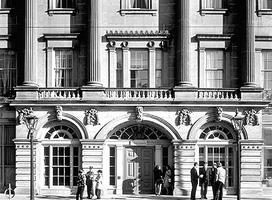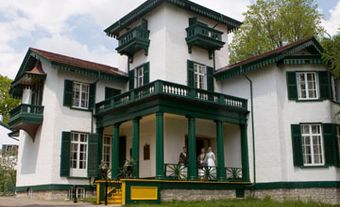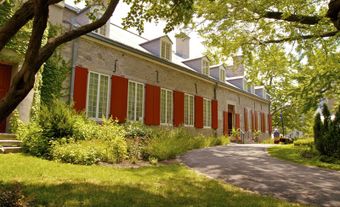
St. Lawrence Hall opened in 1850 and was Toronto’s first large meeting hall. Named for Canada's patron saint, it was for many years the centre of cultural and political life in Toronto, hosting many balls, receptions, concerts, exhibitions and lectures. Prominent Canadian figures such as John A. Macdonald, George Brown and Thomas D’Arcy McGee made public appearances there. In 1967, after a long period of decline, the hall was declared a national historic site and restored in honour of the country’s centennial.
Background
A public hall flanked by shops was built in 1831 as part of a rectangle of buildings making up York's market square. When York was incorporated as Toronto in 1834, the hall became the City Hall for a decade until its successor was built nearby. After the great fire of 7 April 1849 burned down much of the town centre, the area was revitalized by the construction of St. Lawrence Hall and St. James’ Cathedral.
Design
Designed by William Thomas of Toronto, the hall’s architecture reflected the influence of the Renaissance style, with its raised portico over an arcaded base, but reinterpreted in a distinctly Victorian manner. Its richly carved ornamentation, picturesque skyline and the eclectic incorporation of a French mansard roof were typical of contemporary architectural tastes.
Located on the southwest corner of King and Jarvis streets, St. Lawrence Hall was attached by a market annex to the city hall at Front and Jarvis. The building included ground-level commercial storefronts, second-level offices and a 2,700-square-foot assembly room on the third floor that seated 1,000 people for concerts and speeches. A raked balcony at the north end of the assembly room served as a speaker's platform, and a thrust stage was located at the south end.
Notable Events and Uses
Leading political figures John A. Macdonald, George Brown and Thomas D’Arcy McGee addressed Toronto audiences at the hall. Musical activity included recitals by such world-renowned artists as the sopranos Jenny Lind (1851) and Adelina Patti (1853, 1860), violinist Ole Bull (1853) and pianist Sigismund Thalberg (1857). There were performances by the Toronto Vocal Music Society and Toronto Philharmonic Society, minstrel shows and Gilbert & Sullivan productions by Upper Canada College students.
The hall opened shortly after the US Congress enacted the Fugitive Slave Act of 1850 and thousands of African American slaves were fleeing to Canada via the Underground Railroad. The hall became an important meeting place for the Abolitionist movement of the day, hosting the North American Convention of Colored Freemen in 1851 and such influential speakers as social reformers Frances Harper and Henry Bibb.
Decline and Restoration
In the 1870s, the city’s centre shifted away from St. Lawrence Market and towards Yonge Street. By the 1890s, the emergence of bigger, more suitable and more conveniently located performance venues such as Massey Hall brought about a decline in the use of St. Lawrence Hall, and it gradually fell into disrepair. In 1967 it was designated a national historic site and restored as part of a centennial project in the City of Toronto. The assembly room then came into use again for social and corporate functions, and chamber music concerts. The first two Juno Awards ceremonies were held there in 1970 and 1971. From 1948 to 1996, the hall was home to the administrative offices and rehearsal rooms of the National Ballet of Canada.
See also: Toronto Feature: St. Lawrence Hall; Toronto Feature: St. Lawrence Market.
A version of this entry originally appeared in the Encyclopedia of Music in Canada.

 Share on Facebook
Share on Facebook Share on X
Share on X Share by Email
Share by Email Share on Google Classroom
Share on Google Classroom


